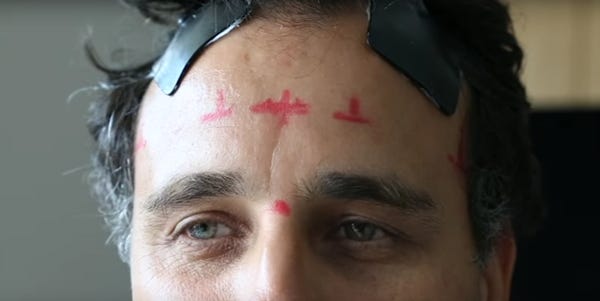Is Electric Brain Stimulation a Memory Booster?
August 10, 2016
University of North Carolina researchers think that targeted electrical currents can modulate brain rhythms while you sleep--a discovery that could lead to new treatments for patients suffering from memory loss.
Kristopher Sturgis

When it comes to consolidating and storing information in the brain, sleep is a crucial part of the process. A recent study out of UNC aims to prove that changes in electrical brain activity during sleep play a big role in memory storage, and can be targeted to enhance memory.
For years, researchers have observed electrical brain activity that oscillates or alternates during sleep, presenting waves on an electroencephalogram (EEG) known as sleep spindles. These sleep spindles have been linked to the process of cataloging and storing memories, and now researchers aim to manipulate these spindles to improve memory.
"Sleep spindles play a functional role in strengthening memories," says Flavio Frohlich, PhD, assistant professor of psychiatry at UNC and the senior author on the work. "We aim at boosting these sleep spindles in patients with memory impairments to improve memory formation processes. Our publication showed that we are able to achieve this in healthy, young people. We hope that our stimulation paradigm will restore impaired sleep spindles, and thereby improve memory and cognitive function."
The process involves the use of a unique form of electrical brain stimulation known as transcranial alternating current stimulation, or tACS. Traditionally, scientists have experimented with tDCS--transcranial direct current stimulation--which provides a constant stream of weak electrical current to the scalp. Caroline Lustenberger, PhD, postdoctoral fellow in the Frohlich lab and first author on the work, says that unlike tDCS, tACS provides the ability to specifically target sleep spindles in real time.
"Our system detects sleep spindles in real time in the EEG signal," Lustenberger says. "We know that brain rhythms are very sensitive to targeted rhythmic stimulation due to resonance. Each time a spindle is detected, we apply a weak electric current with the waveform of a spindle to boost the spindle generated by the brain."
As part of their study, Frohlich and Lustenberger observed 16 male participants as they completed two nights of sleep for their study. Before going to sleep each night, the participants were asked to perform two common memory exercises--associative word-pairing tests and motor sequence tapping tests. During the first night, each participant received a treatment of tACS, and during the second night each participant received a simple dose of placebo stimulation.
Each morning, researchers had the participants perform the same standard memory tests from the night before, and found no improvement for associative word pairing, but a significant improvement in the motor tasks when compared to the results from the placebo dose. Frohlich says this demonstrated a direct causal link between the electric activity pattern of sleep spindles, and the process of motor memory consolidation--a discovery that could lead to improved treatment options for patients suffering from conditions that impair these abilities.
"There are very few treatment options available for memory impairment," Frohlich says. "We hope that our approach could add a new therapeutic option, perhaps administered at home under remote supervision. Importantly, research studies have shown that sleep spindles are impaired in several disorders like Alzheimer's disease and schizophrenia, along with memory consolidation. Identifying approaches that can non-invasively boost these sleep spindles, along with memory formation, are of fundamental importance--and we were able to show that boosting sleep spindles helps increase motor memory consolidation in healthy participants."
Of course, the effects of tACS and tDCS aren't always positive. Last month researchers from the University of Pennsylvania and Harvard University came together to voice their opinions in an open letter. Their message was simple: tDCS can be a dangerous technique for do-it-yourself users who are looking to boost brain function. The process can result in harmful unintended consequences. The Harvard and Penn researchers warn that enhancing one area of the brain could come at the expense of other areas.
Frohlich and Lustenberger remain cognizant of the dangers of electric brain stimulation, and are adamant that this technique will adhere to every possible safety standard, and meet all FDA requirements. They also plan to continue to study the technique to better identify how memories are affected by the boosting of sleep spindles.
"The next step will be to apply this approach to patients suffering from spindle impairments," Lustenberger says. "Furthermore, studies will be performed to identify which types of memories benefit from boosting sleep spindles. Developing a new FDA cleared treatment is a long, complex, and expensive pathway. Well controlled studies with a large number of patients with different disorders need to be performed to identify the efficacy of our approach in improving memory -- and this will likely take several years."
Kristopher Sturgis is a contributor to Qmed.
Like what you're reading? Subscribe to our daily e-newsletter.
[Image courtesy of UNC]
About the Author(s)
You May Also Like

.png?width=300&auto=webp&quality=80&disable=upscale)
